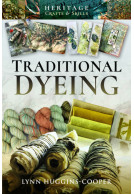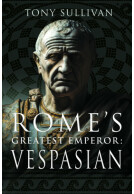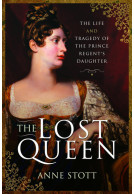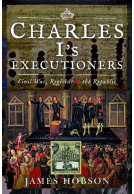Felting (Paperback)
Imprint: Pen & Sword History
Series: Heritage Crafts and Skills
Pages: 128
Illustrations: 32 black and white illustrations
ISBN: 9781526724649
Published: 21st May 2021
(click here for international delivery rates)
Need a currency converter? Check XE.com for live rates
| Other formats available | Price |
|---|---|
| Felting ePub (3.0 MB) Add to Basket | £6.99 |
This book offers a journey through the history of the ancient craft of felting from the earliest times, when people first discovered that animal fibre, moisture and friction created a durable, warm fabric. Felt has been used for everything from apparel to housing; it has been used for practical, decorative and even religious applications. This book looks at the rise and fall of felting through history and into the industrial era, including its importance to the hat-making industry.
The second part of the book brings us to the modern - and some might say, golden - era of artisanal felting with interviews from felters and textile artists generously sharing their creative process.
Finally, if you are inspired to try this fascinating craft, there are step by step instructions for both wet and needle felting, and a useful list of resources to get you started on your own felt-making journey.
This is the latest title in P&S's excellent series on handicrafts and hobbies, this time the making of artefacts etc., with felt. From the images on the front cover you can see just how brilliant the results can be, and the book is written by an expert. Really, really superb.
Books Monthly
Rating: 5 out of 5 stars
NetGalley, Rachel Pollock
Felting by Lynn Huggins-Cooper is an interesting new book out through Pen & Sword Books on the history of the felting practice. This title will be of particular interest to contemporary and theatrical milliners/hatters working in the medium. There are several chapters devoted to the technological process and shift in methods/purposes for felting throughout history.
Other aspects of interest: there's a lengthy section of interviews with artisans working with the process/medium, and helpful "how-to" chapters concerning the difference between wet felting and needle felting. There's also a helpful directory of suppliers.
Felting is something I always wanted to learn to do and now this excellent book explains it in detail (and historically) and it is actually easy to do! The instructions are clear and concise and in no time flat, and at not a huge cost, you, too can felt your way through crafts and maybe even make yourself a hat!
NetGalley, Janet Pole Cousineau
This book provides a great history of and introduction to the craft of felting, describing the tools used and the craftsmen that use them to create fantastical things.
NetGalley, Markey Olson
If you are interested in the history of felting then this book is definitely for you. It has been very well researched and full of facts about this amazing craft. The section of interviews I found very inspiring, and then there is a brief how to for wet felting and needle felting. I thought the book flowed really well as after reading all about it, I just wanted to make something myself so having a directory of suppliers near the end is a very good touch. The felting glossary is also very useful. I enjoyed reading this very interesting book and recommend it.
NetGalley, Tammy Muir
This is a good, accessible, clearly written introduction to felting materials and technique. The series as a whole would be superlative for library acquisition, maker's groups, homesteaders, historical re-enactors, and similar uses.
NetGalley, Annie Buchanan
Felt has probably been around as long as there have been sheep on God’s green earth. Reading this book I discovered that plant fibers such as rose, nettle, and sea cell can also be used to create felt. It’s older than spinning and weaving. Felt caps have been found and dated back 3500 years to the Bronze Age. Pompeii had felt glove and hat workshops. Huggins-Cooper relates the history of felt, the different types of felt, and includes short bio’s of leading artisans. I had not even heard of needle felting until 2017, but I have found it to be a fascinating craft that uses wool as a sculpting medium. As a knitter I was aware of felting knitted garments to create a thicker, warmer fabric, but the craft can be expanded for even greater artistic expression.
NetGalley, Mary Vernau
Recommended for crafters who are interested in the history and diversity of felting.
Rating: 5 out of 5 stars
NetGalley, Catherine Hankins
I haven't done as much felting as I'd have liked, but my daughter has created some really cute things felting! I enjoyed reading this book and learning about the history of the art form. I knew some hats were felted, but never really gave to much thought to other items that were also felted through the ages! Interesting book and does include some instruction for the craft.
When I think of felting, I imagine cute bunnies and foxes made by an indulgent grandmother. It turns out that felting has a long and storied history, beginning in the dark ages, when felted objects often had religious significance. Readers will trace the craft from ancient time up to today, with explanations of the difference between dry and wet felting and even a felting project they can create. An interesting and informative book.
NetGalley, Rosemary Smith
This book covers the history of felting from its ancient beginnings to today.
NetGalley, Jenny Lodge
It's a lovely read for people with an interest in history, crafts, and how time has changed the process. I really enjoyed the artisan interviews, what a lovely insight into such creative people.
There are a couple of 'how-to' guides and lots of links on where to access more guides and supplies.
There are also some beautiful photos of felt creations, and they are incredible.
About Lynn Huggins-Cooper
Lynn Huggins-Cooper is a widely published author. When she is not writing, she is in the studio creating art for exhibition. She is a textiles artist, working in natural and found materials, and mixed media, and her work is influenced by the 360 hectare woodland that begins at the bottom of her garden. She is a member of the Heritage Crafts Association, and the International Felt makers Association. She is also a mentor for Applied Arts Scotland. She lives with her husband in the north-east of England.



















